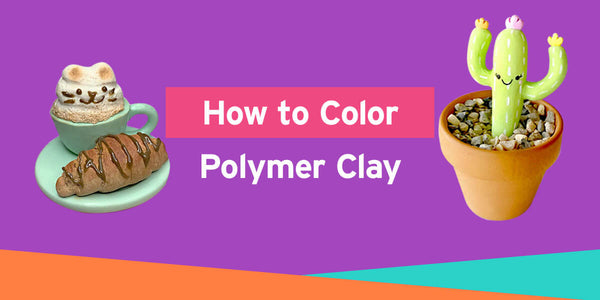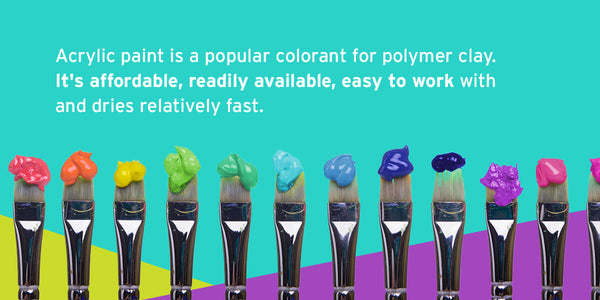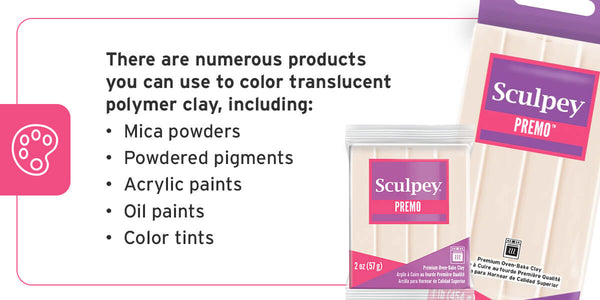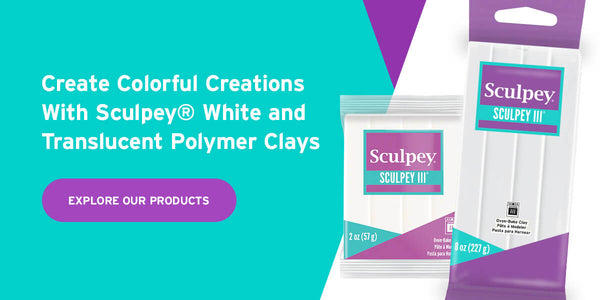
If you can't invest in every color of polymer clay for your crafts, you can keep the costs low and maximize the number of shades you can achieve by coloring white or translucent polymer clay. Coloring polymer clay lets you customize and authenticate your creations, such as jewelry, ornaments, picture frames or decor pieces.
There are many ways to color polymer clay crafts. Some methods involve painting on the baked and ready polymer clay crafts, while others involve incorporating color in the “raw” clay. Experimenting with different colors and coloring methods allows you to discover new designs, styles, textures and finish options that elevate your projects.
Distinguishing Coloring Pigments Versus Dyes
Before getting into the details of how to color polymer clay, we need to distinguish between two of the most common terms you'll encounter: pigments and dyes. While these two terms are used interchangeably, they could not be more different.
Pigments refer to finely ground particles contained in a substance like oil or water. Dyes refer to synthetic or natural chemicals combined to create a coloring substance. Pigments combine better with binding substances to produce vibrant and intense colors, while dyes don't require mediums or binding substances to infuse their permanent coloring effects.
Dyes don't separate, but they can fade, especially when working with low-quality dyes. You can purchase powdered or pre-mixed pigments or make your own using colored pencils or chalk shavings. Both pigments and dyes can be used to color either white or translucent polymer clay. However, pigments are better for use with unbaked polymer clay because alcohol-based polymer clay dyes can negatively impact the clay's curing process.
How to Color White Polymer Clay
Coloring white polymer clay is a fun and effective way to achieve different colors and designs. Because of the white pigment in the clay, you may not be able to achieve the exact shades you're looking for. Nonetheless, you can adjust the amounts of colorants you use to get very close to the true colors.
When coloring white polymer clay, you'll often end up with pastel colors such as pink when you use red pigment or baby blue when you add blue pigment. Below are the top colorants you can use for white polymer clay and instructions on using each:
Acrylic Paint

Acrylic paint is a popular colorant for polymer clay. It's affordable, readily available, easy to work with and dries relatively fast. It may be used before baking to create a perfect bond between the polymer clay and the paint as it cures. You can also use acrylic paint after baking polymer clay crafts because the medium doesn't shrink or expand as it cures.
Painting your polymer clay craft after it's cured and completely cooled is the safest choice, as it prevents the distortion of delicate, unbaked clay creations. Water-based acrylic paints are the best for painting cured polymer clay crafts. They provide sufficient coverage and adhere well to baked polymer clay surfaces. You'll still need to test the paint and check how it interacts with your craft before locking it. Coating your craft with Sculpey glaze will create a seal that preserves the colors and prevents fading over time, especially with exposure to direct sunlight.
Please note that sometimes polymer clay crafts form an oily film as they bake. This may prevent the acrylic paint from adhering to your creations. You can remove the film using rubbing alcohol and a piece of cloth. Be sure to give the alcohol time to evaporate completely before applying the acrylic paint. You also need to ensure the craft surface is free of any dust and debris to achieve a smooth finish.
Because acrylic paint is water-based, be cautious when adding it to unbaked clay. To incorporate acrylic paint into unbaked polymer clay, add a few drops of the paint to the clay and knead until well distributed. Avoid adding excess acrylic paint to your unbaked paint because it'll take longer to evaporate. When the water does not evaporate completely, it may result in bubbling on the surface of the clay, excessive hardening or brittle results.
Oil Paints
Oil paints or oil pastels with a vegetable oil base are effective colorants for polymer clay crafts. Avoid petroleum-based oil paints because they deteriorate the clay. Oil paints are highly pigmented and are most suitable for creating gradient or blended effects. You can use them directly on white polymer clay or thin them with a medium to maintain the light transmission property on translucent clay.
When working with oil paints, you must give each layer ample time to dry completely before applying the next. You can apply as many layers as you need to achieve your desired color depth, but let each one dry well to prevent smudging the painted polymer clay surface. Seal your oil-painted polymer clay creation with varnish or a sealer to prevent fading, peeling, scratching or chipping.
Mica Powder
Mica powder is a coloring agent that adds color and texture to your polymer clay crafts. The appeal of using mica powder with polymer clay crafts is that it produces a glittery, shimmery shine, which is especially desirable when creating jewelry. The powder contains different sizes of mica powder flakes with metal oxides and pigments that render them their colors.
The flakes reflect light and can be coated to bounce back the light in multiple colors. Larger mica powder flakes are more sparkly because they reflect more light. Mica powders mix well with unbaked polymer clay because it's naturally soft and sticky, so the flakes attach easily. Use your fingers or a soft, wet paintbrush to apply and burnish the flakes to achieve the perfect shine.
There are several other ways you can add mica powder to baked or unbaked polymer clay crafts:
- Mix them into your favorite clear varnish or clearcoat and apply them to baked polymer clay creations.
- Apply them to baked clay using a thin layer of liquid clay or special types of glue.
- Apply them through a silkscreen.
- Apply the mica powder flakes on a rubber stamp or textured sheet and press them onto raw unbaked polymer clay.
Powdered Pigments
There are many forms of powdered colors you can use to create intriguing color blends and transitions in white Sculpey polymer clay. Chalks and chalk pastels are popular powdered pigments that easily mix into polymer clay. They're relatively affordable and readily available in the art supplies section of most craft stores. They last long and are easily applied using a nice soft brush.
Colored pencil shavings and watercolors also do a brilliant job of coloring polymer clay. Knead these into your polymer clay until evenly mixed and you achieve your desired craft color. The main advantage of powdered pigments is that they don't introduce liquid into the clay, which often requires more drying time and may cause bubbling if water gets trapped during curing.
Color Tints
Color tints are intense and highly concentrated pigments that color Liquid Sculpey and white or translucent Sculpey polymer clay. These vibrant, permanent inks hold tons of coloring potential because you can mix the shades to create unique custom colors. The color tint coloring bottles have precision tips that allow accurate and seamless coloring.
The solution mixes well with your clay and dries fast without forming bubbles. These tints are easy to use for beginners, intermediate and advanced polymer clay crafters. Color tints won't fade even when exposed to direct sunlight or heat, so there's no need to seal your polymer clay crafts in the end. Here are the steps to follow when coloring polymer clay creations with color tints:

- Shake the color tint bottle well to evenly spread the pigment in the solution.
- Wear gloves and protective clothing and lay out a nonporous work surface such as the Sculpey Oven-Safe Work Mat because the highly pigmented ink stains clothing, surfaces and skin.
- Roll out your polymer clay on the work surface.
- Add a few drops of the color tint onto your polymer clay.
- Knead the polymer clay until you achieve the desired color, adding more tint as needed.
- Bake your polymer clay craft following the instructions on the packaging. Use an oven thermometer for the best accuracy.
A Sculpey mixing chart is a great resource for possible tint combinations.
Paint Pens
When adding colorful designs to polymer clay crafts, you can use regular markers or paint pens. They come in a variety of opaque colors, like black and metallics, and dry pretty fast when applied to polymer clay. These create elaborate designs on baked polymer crafts but fade over time, especially with exposure to sunlight and heat. Even when you seal them with polymer clay varnishes, the paint pens will bleed.
How to Color Translucent Polymer Clay
Translucent polymer clay makes an excellent base for coloring because it lets you achieve deeper colors. It might not turn out exactly like your favorite Sculpey Premo polymer claycolors, but it gets close enough because it absorbs most of the pigment from your coloring agent. Translucent clay allows you to create more color effects than white polymer clay and recreate fun designs like faux stained glass effects.
While more paint or dye intensifies the color, too much may inhibit the translucency of polymer clay because the pigment blocks the light transmission properties. It's also important to note that cheap coloring agents have a low tinting strength, which refers to the depth and vibrancy of a color. You'll need more than you would when using higher-quality colorants with fine dye or pigment particles that easily achieve deep colors and maintain translucency.

There are numerous products you can use to color translucent polymer clay, including mica powders, powdered pigments, acrylic paints and oil paints. Alcohol inks provide the best results because they maintain clay's translucency.
Using Alcohol Inks to Color Translucent Clay
Alcohol inks are permanent, intensely concentrated dyes dissolved in alcohol that you can use to color white Sculpey clay or translucent polymer clay. The dyes readily disperse in the clay because polymer clay is soluble in alcohol. They come in dropper bottles and are available in a wide variety of colors, from vibrant hues to subtle shades of brown and gray.
They are better suited for coloring translucent over white polymer clay because they don't contain particles that obstruct light. They enhance or maintain the light transmission properties of translucent clay and recreate faux-colored glass effects. In excess amounts, alcohol inks, especially darker-colored ones, will inhibit light transmission in the clay.
You can use alcohol inks with either baked or unbaked polymer clay creations. Here's how:
- Cover up or wear old clothes because alcohol ink can get very messy and doesn't easily wash out.
- Place your translucent polymer clay on a nonporous work surface, such as a metal sheet, oven-proof glass, ceramic tile, index cards, aluminum foil or the Sculpey Oven-Safe Work Mat.
- Spread the translucent polymer clay into a thin layer to ensure the alcohol ink dries faster.
- Pour a few drops of alcohol ink on the translucent polymer clay and knead to mix them well.
- Continue kneading and adding more alcohol ink until the pigment is evenly distributed and you achieve your desired color.
- Let the alcohol ink air dry before you pop your polymer clay craft into the oven.
When using alcohol inks to color translucent clay, use a few drops at a time and add as needed to enhance coverage or color depth. Adding lots of alcohol ink at once to polymer clay projects stretches the time required to dry your craft. You can seal your now-colored project using resin. Avoid using varnish and glazes that may cause the alcohol ink to run.
There are some things to keep top of mind when working with alcohol inks to color translucent polymer clay:
- Alcohol ink can bleed out of unbaked polymer clay, so avoid layering different colored pieces of polymer clay.
- The color you get on your polymer clay craft may differ slightly from what you have on the alcohol ink bottle.
- Alcohol ink colors may change or fade with exposure to sunlight or heat, so you can expect some color change when you pop your creation into the oven.
Create Colorful Creations With Sculpey® White and Translucent Polymer Clays
Coloring polymer clay is a fun way to create authentic crafts, including jewelry, figurines and home decor pieces. For your creations to turn out as you envision or better, you must start with high-quality white or translucent polymer clay. Sculpey provides crafters at all levels with high-quality clay that's durable, versatile and to work with.
Our variety of white polymer clays is easy to use for kids, beginners and general crafters. They take on colors well, sift and stay soft as you knead to incorporate colors until you pop your crafts into the oven. We also have translucent variants that achieve mesmerizing colors and depth when colored using alcohol inks, mica powders or powdered pigments.
Explore our product pages for a look at our wide selection of polymer clays. You can also check out our blogs and how-to-pages for inspiration on your next polymer clay creations.



